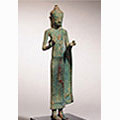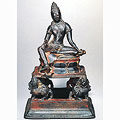 |
|
 |
 |
 |
 |
 |
 |
 |
 |
Sculpture from Thailand
Local inscriptions and Chinese historical accounts mention a number of political and cultural centers in Thailand from the 7th through 12th centuries, the time period encompassed by the dozen Hindu and Buddhist Thai sculptures in the Asia Society's collection. This presence of different ethnic groups in Thailand is reflected in the diversity of style and iconography among the Asia Society's images. From about the 6th to the 11th centuries, central Thailand seems mainly to have been inhabited by the Mon people. This area is often referred to as Dvaravati, although its boundaries remain unclear and the term Dvaravati may describe only one of many kingdoms, all inhabited by Mons. In addition to sculptures produced by the Mon people, the collection contains a number created by the Khmer, based in present-day Cambodia, who ruled much of Thailand from the 9th century to the 13th century. Peninsular Thailand, the southernmost part of the country, was ruled by the Shrivijayan empire beginning in the 7th century and was the dominant force in the region between the 8th and the 13th centuries. |
 |
 |
| 1 thru 12 of 12 |
 |
| view text only list |
 |

Head of Vishnu |
 |

Bodhisattva Maitreya |
 |

Male Figure |
 |

Buddha |
 |

Buddha |
 |

Head of Buddha |
 |

Buddha and Attendants |
 |

Head of Buddha |
 |

Head |
 |

Crowned Buddha |
 |

Bodhisattva Manjushri |
 |

Bodhisattva |
 |
|
 |